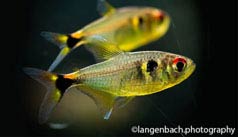

Alternative species (click on the thumbnail to see the card)

Hemigrammus erythrozonus

Hemigrammus ocellifer ocellifer

Pristella maxillaris
Names
Scientific name
Hyphessobrycon pulchripinnis
Hemigrammus erythrophthalmus
Common name
Lemon tetra
Origin

Origin: South America, Brazil
Biotope: Amazonian
Dimorphism

The male has no black band in the anal fin
Group

Characidae
Volume

80 L / 18 imp gal / 21 US gal
Parameters

T°: 23 to 27°C or 73 to 81°F
pH: 6 to 7.5
Hardness: 8 to 13°dGH
Difficulty

Easy
Size

3 to 5 cm (1.2 to 2")
Longevity

2 to 4 years
Living zone

Middle
Individuals

10
Food
How to feed the Lemon tetra?
Food
How to feed the Lemon tetra?
The Lemon Tetra is not complicated about its food. It is an omnivorous fish, that is, it needs meat and vegetables.
You can give dry foods like glitter or pellets, sold commercially, for a daily basis. However, it is important to vary your meals for two reasons: health and beauty! Indeed, varied meals will encourage beautiful colouring, active behaviour and avoid deficiencies.
You will also notice its preference for artemia and worms!
Beware of overeating that is harmful and pollutes the water in your aquarium. You can feed it once a day.
Behavior
What kind of behavior does the Lemon tetra have?
Behavior
What kind of behavior does the Lemon tetra have?

In general, this fish is quite active and lively. It is nonetheless peaceful. It will animate your aquarium pretty well all day long.
During breeding periods, they become particularly active. Males become particularly demonstrative towards females, and can sometimes bicker between them. Do not worry, there is no danger for your fish because these parries are quite harmless.
Lemon Tetra is a gregarious species that likes to live with others. For their well-being, it will be necessary to adopt them into a fairly large group (at least 10 individuals). It is a vital condition for it to feel good. If kept alone or in too small numbers, this robust fish may become susceptible to stress and disease.
Cohabitation
Who can live with the Lemon tetra?
Cohabitation
Who can live with the Lemon tetra?
The Lemon Tetra is a good candidate for the community aquarium. It will be able to live easily with other peaceful fishes. In reality, it simply ignores its roommates! For example, in appropriate volumes, it can easily associate with other members of the Hyphessobrycon family.
Be careful, however, of the presence of large fish because the Lemon Tetra could then serve as a meal. In addition, they can be quite stressed and intimidated by such giants.
Breeding
How to breed the Lemon tetra?
Breeding
How to breed the Lemon tetra?
The breeding of Hyphessobrycon pulchripinnis is not very difficult. It can take place in the community aquarium but the chances of survival of fry are very low because of predation.
To increase the survival rate of the fry, set up an aquarium specifically dedicated to the breeding. It will be at least 30 liters / 6.6 Imp Gal / 8 US Gal, with filtering on exhauster and plants (Echinodorus, Java moss that will serve as a pantry for fry). Place a very fine mesh over the entire surface, about 4 cm or 1.5 inches from the floor of the aquarium: this will allow the eggs to fall underneath. Parents will not have access. Some floating plants will be a plus. The water should be exactly the same as the main tank. Good results are obtained according to the following parameters: pH ranging from 6 to 6.5, temperature at 25/26°C or 77/79°F and FRESHWATER.
Introduce 2 males and 3 to 4 females in this aquarium and stimulate them for spawning by distributing live food (daphnia, collembola...). Before spawning, the male performs a parade to attract the female to its territory. The nesting sites vary. The couple can choose to spawn on plants or directly on the substrate. The laying is usually done in the morning. Normally, you will be able to withdraw the parents around 12 o'clock because the laying will take place. Be that as it may, as soon as the eggs appear, remove the parents.
It is then very quickly necessary to protect the eggs from the light because they are photosensitive. For example, surround the breeding aquarium with cardboard and turn off the light. This protection must be maintained for at least a week. After that, gradually uncover your tray by removing a cardboard from one side every 2 days.
The eggs will hatch after 2 to 3 days maximum. The fry will swim freely after 4 additional days.
Food fry: infusoria the first time, then micro-worms, eels, nauplies artemia (adapt the size of the food according to the size of fry).
They can join their parents in the main aquarium after one or two months depending on the growth rate.
Its aquarium
Which aquarium for the Lemon tetra?
Its aquarium
Which aquarium for the Lemon tetra?
In its natural habitat, the lemon tetra lives in streams or flooded forests where the water is clear with a slight current. Be sure to reproduce these simple conditions for your well-being.
This will require proper maintenance of your aquarium and ensure good water quality. Regular water changes and good filtration will help you to guarantee this result. In addition, such filtration will create a bit of power, much appreciated.
As for decor, opt for a dark substrate. The lemon tetra will appreciate the presence of many plants and roots. Floating plants such as Pistia will also be welcome. Indeed, these elements will offer hiding places and will thus reinforce the sense of security of the fish. At ease in such an aquarium, its behaviour will be all the more pleasant! Be careful not to overload the environment. It must be able to spend its energy! Leave enough room for it to swim freely. In this respect, do not hesitate to choose a tank with a good length facade.
Good To know
Find all additional information!
Good To know
Find all additional information!
In case of stress, the lemon tetra can lose its beautiful colours. A poor diet can also be at the origin. Check your diet and environment if your fish tarnished.
Robust, easy to acclimatise and maintain: an ideal candidate for beginning aquarists! It is also very appreciated for its qualities and you can find it quite easily in the trade.
There is a variety called "Bolivia" of this species:

Yours photos!
Comments
Sort by:
Please login to post comments

